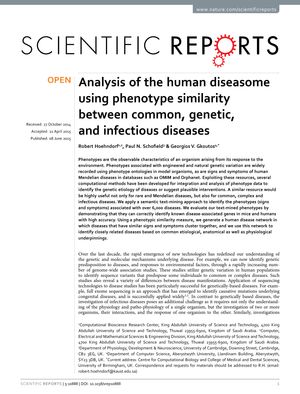Analysis of the Human Diseasome Using Phenotype Similarity Between Common, Genetic, and Infectious Diseases
June 2015
in “
Scientific Reports
”

TLDR The study found that diseases can be grouped by symptoms and that the accuracy of predicting disease-related genes varies with the data source.
The document detailed a study that used a semantic text-mining approach to analyze over 6,000 diseases by their phenotypes, which are signs and symptoms. The study aimed to identify phenotypic similarities among common, genetic, and infectious diseases and to evaluate the accuracy of these phenotypes in identifying disease-associated genes. The researchers created a human disease network based on phenotypic similarity, which grouped diseases with similar characteristics. They found that the number of disease-phenotype associations needed for accurate gene prediction varied by dataset: 9 for mouse models, 21 for OMIM gene-disease associations, and 36 for genes involved in a disease in mice. The study also showed that combining text-mined phenotypes with those from the OMIM database slightly increased the accuracy of predicting candidate genes for diseases. The results of the study are available online and offer a resource for further research into disease-associated phenotypes.